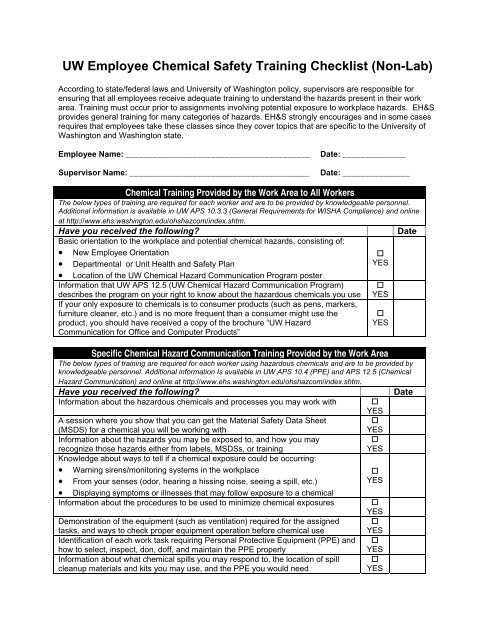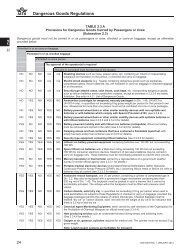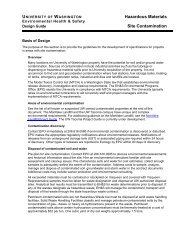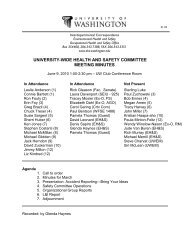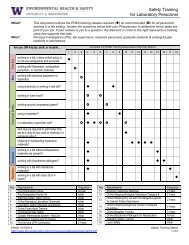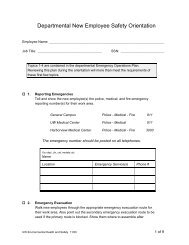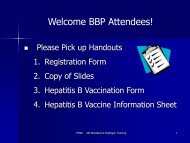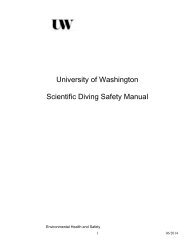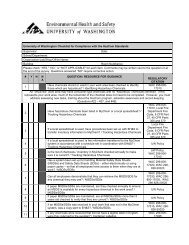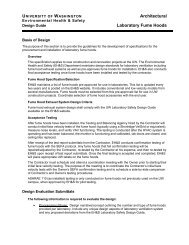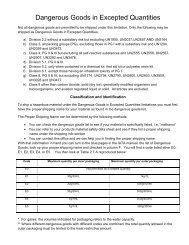UW Employee Chemical Safety Training Checklist - Environmental ...
UW Employee Chemical Safety Training Checklist - Environmental ...
UW Employee Chemical Safety Training Checklist - Environmental ...
You also want an ePaper? Increase the reach of your titles
YUMPU automatically turns print PDFs into web optimized ePapers that Google loves.
<strong>UW</strong> <strong>Employee</strong> <strong>Chemical</strong> <strong>Safety</strong> <strong>Training</strong> <strong>Checklist</strong> (Non-Lab)<br />
According to state/federal laws and University of Washington policy, supervisors are responsible for<br />
ensuring that all employees receive adequate training to understand the hazards present in their work<br />
area. <strong>Training</strong> must occur prior to assignments involving potential exposure to workplace hazards. EH&S<br />
provides general training for many categories of hazards. EH&S strongly encourages and in some cases<br />
requires that employees take these classes since they cover topics that are specific to the University of<br />
Washington and Washington state.<br />
<strong>Employee</strong> Name: _________________________________________<br />
Supervisor Name: ________________________________________<br />
Date: ______________<br />
Date: _______________<br />
<strong>Chemical</strong> <strong>Training</strong> Provided by the Work Area to All Workers<br />
The below types of training are required for each worker and are to be provided by knowledgeable personnel.<br />
Additional information is available in <strong>UW</strong> APS 10.3.3 (General Requirements for WISHA Compliance) and online<br />
at http://www.ehs.washington.edu/ohshazcom/index.shtm.<br />
Have you received the following<br />
Basic orientation to the workplace and potential chemical hazards, consisting of:<br />
• New <strong>Employee</strong> Orientation<br />
• Departmental or Unit Health and <strong>Safety</strong> Plan<br />
• Location of the <strong>UW</strong> <strong>Chemical</strong> Hazard Communication Program poster<br />
Information that <strong>UW</strong> APS 12.5 (<strong>UW</strong> <strong>Chemical</strong> Hazard Communication Program)<br />
describes the program on your right to know about the hazardous chemicals you use<br />
If your only exposure to chemicals is to consumer products (such as pens, markers,<br />
furniture cleaner, etc.) and is no more frequent than a consumer might use the<br />
product, you should have received a copy of the brochure “<strong>UW</strong> Hazard<br />
Communication for Office and Computer Products”<br />
<br />
YES<br />
<br />
YES<br />
<br />
YES<br />
Specific <strong>Chemical</strong> Hazard Communication <strong>Training</strong> Provided by the Work Area<br />
The below types of training are required for each worker using hazardous chemicals and are to be provided by<br />
knowledgeable personnel. Additional information Is available in <strong>UW</strong> APS 10.4 (PPE) and APS 12.5 (<strong>Chemical</strong><br />
Hazard Communication) and online at http://www.ehs.washington.edu/ohshazcom/index.shtm.<br />
Have you received the following<br />
Information about the hazardous chemicals and processes you may work with<br />
A session where you show that you can get the Material <strong>Safety</strong> Data Sheet<br />
(MSDS) for a chemical you will be working with<br />
Information about the hazards you may be exposed to, and how you may<br />
recognize those hazards either from labels, MSDSs, or training<br />
Knowledge about ways to tell if a chemical exposure could be occurring:<br />
• Warning sirens/monitoring systems in the workplace<br />
• From your senses (odor, hearing a hissing noise, seeing a spill, etc.)<br />
• Displaying symptoms or illnesses that may follow exposure to a chemical<br />
Information about the procedures to be used to minimize chemical exposures<br />
Demonstration of the equipment (such as ventilation) required for the assigned<br />
tasks, and ways to check proper equipment operation before chemical use<br />
Identification of each work task requiring Personal Protective Equipment (PPE) and<br />
how to select, inspect, don, doff, and maintain the PPE properly<br />
Information about what chemical spills you may respond to, the location of spill<br />
cleanup materials and kits you may use, and the PPE you would need<br />
<br />
YES<br />
<br />
YES<br />
<br />
YES<br />
<br />
YES<br />
<br />
YES<br />
<br />
YES<br />
<br />
YES<br />
<br />
YES<br />
Date<br />
Date
Information about the proper disposal of all waste chemicals<br />
Have you received training on:<br />
• The <strong>UW</strong> <strong>Chemical</strong> Hazard Communication program in WAC 296-800-170, <strong>UW</strong><br />
APS 12.5 and supporting EH&S web pages<br />
• Available resources concerning chemical hazard controls (supervisor, job<br />
hazard analyses, EH&S, etc.)<br />
<br />
YES<br />
<br />
YES<br />
EH&S-Provided <strong>Chemical</strong> <strong>Safety</strong> <strong>Training</strong><br />
Answer the following questions. If YES, fill in the date when the training is completed. For more information<br />
about the classes, see http://www.ehs.washington.edu/psotrain/index.shtm or contact the EH&S <strong>Training</strong> Office<br />
at ehstrain@u.washington.edu or 206.543.7201.<br />
Date<br />
Do you work in or potentially enter any building that may contain asbestos<br />
No Yes If Yes, take the Asbestos Awareness class. REQUIRED ANNUAL *<br />
Will you be maintaining the chemical inventory for your work area<br />
No Yes If Yes, take the MyChem class.<br />
Do you need to wear a respirator on the job<br />
No Yes If Yes, follow the instructions at:<br />
http://www.ehs.washington.edu/ohsresp/index.shtm. REQUIRED<br />
Are you planning to work with Select Agents<br />
No Yes If Yes, contact the EH&S Research and Biosafety Office at<br />
206.221.7770 additional training may be required. REQUIRED<br />
Do you package, ship, and/or transport hazardous chemicals<br />
No Yes If Yes, take the Shipping and Transporting Hazardous Materials<br />
class biannually. REQUIRED<br />
Do you handle cylinders containing hazardous, toxic, or flammable compressed gases<br />
No Yes If Yes, you should take the Compressed Gas <strong>Safety</strong> class.<br />
Have you volunteered to be one of the First Aid and CPR staff for your lab<br />
No Yes If Yes, take the First Aid and CPR Certification class.<br />
Are you expected to use a fire extinguisher in the event of an emergency<br />
No Yes If Yes, take the Fire Extinguisher <strong>Training</strong> class annually. REQUIRED<br />
Additional Specific <strong>Training</strong> for <strong>Chemical</strong> Exposures<br />
Use this section for any additional training needed due t o work task requirements such as more advanced<br />
asbestos training (*this supersedes general asbestos awareness training), lead training, confined space entry,<br />
hydrofluoric acid, the use of monitoring equipment ,available from EH&S, or from contracted trainers.<br />
After all of the training has been completed have the new employee sign and date this form and save it in your<br />
laboratory training records.<br />
<strong>Employee</strong> Name: __________________________________ Date: ______________


